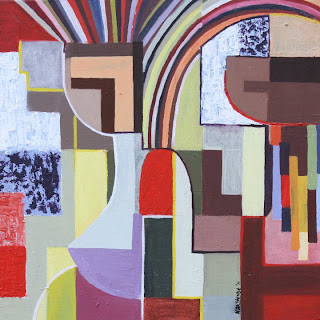Sheila Nakitende | Ugandan Artist b.1983-Present
Sheila Nakitende, Ugandan Artist was born in the Kampala in 1983 - Her work below entitled, "Untitled, 2011" is up for auction next week - 13th March 2012 - This painting comes from a series of works Sheila created in 2011 to do with deconstruction and reconstruction. Breaking down the standard ideas normally associated with Contemporary African Art and moving away from commercial art for the tourists and into the world of Abstraction.
Title: Street Queens
Title: Mother & Child Title: Migration
These initial paintings in the series are more traditional and what is expected of an artist of East Africa, depicting women or girls at play or Mother and child scenarios. The most commonly seen icon of East Africa is that of women carrying jugs on their heads. Portraying woman as objects of desire, shown topless and dancing in the villages; lit only by the light of a full moon. The idea of the hard-working, down-trodden, exotic-African seems to be norm in Kampala but, as we can see, Sheila moves away from this iconography and campaigns in a new direction. Splitting up the elements of the rather dated visions of village life within the Continent and opting instead to highlight and focus in on an emerging African modernity. Sheila works her palette into a more up-to-date version of femininity in modern Africa with such wonderful optimism; one that discovers that woman are capable of intelligence; of greatness. Women working with mathematics, geometry, colour and flare. The possibilities of creating cities as architects, structural engineers and town planners. Sheila is creating a blueprint that is multi-coloured but serves as the building blocks for a brighter future, not only for women but for all Ugandans - The radical notion that women are now capable of creating their own future and even driving their own 4x4 vehicles must be something of a threat to more traditional Ugandans but the wave of change has arrived - the Airport Artists have flown and gone away and Sheila's paintings begin to display a new narrative in the East African artistic dialogue and we see women communicating in far more realistic and natural ways. Showing a different face in art, one which is multi-racial and highly cultural, the face of a truly modern Africa. These works sincerely celebrate the changing attitudes towards women but not through the eyes of the men but through the eyes of themselves with a new feminine confidence and self-belief.
To understand the make up of a National Aesthetic or series of Aesthetics take a look at what wiki says:
The next series of paintings Sheila begins to shred away from the expected in search of a place to be heard on a far grander international arena. The initial hurdle is to speak the correct visual language in order to find a receptive audience. Sheila has certainly done her homework and in the subsequent paintings we see her give birth to artworks that can be defined as Ugandan Abstraction. She cleverly plays around with the standard visual language and with her colourful ribbons, breaks-down the unhealthy stereotypical accepted customs of the Ugandan artistic practitioners and in doing so she becomes a maverick artist in the process.
Title: First Class, Middle Class
The last four paintings in the series start to play with the mere suggestion of shape and form. Using the palette in a similar style to the Abstract Expressionists of the New York School of the 1960's, with the simple push and pull effect that expresses juxtaposed colourful metaphors. Defining a new era of art in a country so famed for disaster. The palette knife has been quietly used to encourage texture telling the audience to take the rough with the smooth and judge accordingly. The subtly in these works shows the artist to have a maturity that is beyond her years. Here we see a true artist wielding her paintbrush to her canvases, as a conductor would his baton to an orchestra. This is a fantastic body of work that will be spoken about in years to come. They will be seen as the works that are the break through in regards to modern femininity in East Africa and be amongst artworks that echo a sense of purpose and direction. They are sure to be apart of a series of extraordinary moments in Contemporary African History and fall in ranks of the other great female artists in East Africa, some of whom are presently enjoying an innovative global unveiling of respect for female African artists, living and working on the Continent.














Comments
Post a Comment